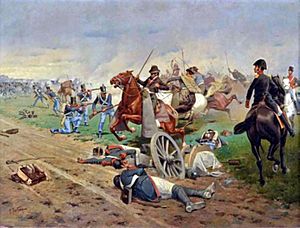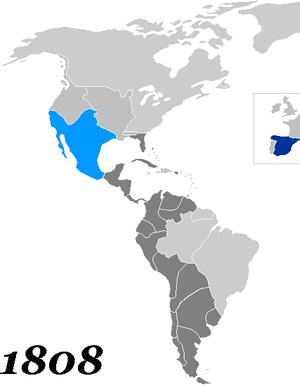Battle of Tucumán facts for kids
Quick facts for kids Battle of Tucumán |
|||||||
|---|---|---|---|---|---|---|---|
| Part of Argentine War of Independence | |||||||
 Battle of Tucumán, oil on canvas by Francisco Fortuny |
|||||||
|
|||||||
| Belligerents | |||||||
| Commanders and leaders | |||||||
| Strength | |||||||
| 1,800 men | 3,000 men 13 cannons |
||||||
| Casualties and losses | |||||||
| 80 killed 200 wounded |
450 killed 690 prisoners 13 cannons captured |
||||||
The Battle of Tucumán was a major battle fought on September 24 and 25, 1812. It took place near the city of San Miguel de Tucumán in Argentina. This battle was a key moment in the Argentine War of Independence.
In this fight, the Army of the North, led by General Manuel Belgrano, won a big victory. They defeated the royalist troops, who were loyal to Spain. The royalist army, led by General Pío de Tristán, had almost twice as many soldiers. This victory stopped the Spanish from moving further into Argentina's northwest. Along with the Battle of Salta in 1813, the win at Tucumán helped Argentina keep control of its borders.
Contents
Why did the Battle of Tucumán happen?
The situation before the battle
The region of Upper Peru (which is now Bolivia) was back under Spanish control. This happened after the rebel forces lost badly at the Battle of Huaqui. The rebel commander, Juan José Castelli, was not very experienced. He was easily defeated by the Spanish army.
On February 27, 1812, Manuel Belgrano was put in charge of the Army of the North. His headquarters were in Jujuy. Belgrano's main goal was to boost the spirits of his soldiers. They were feeling down after the defeat at Huaqui.
Belgrano's plan and the Jujuy Exodus
To inspire his troops, Belgrano raised a new flag he had designed. This happened on May 25 in Jujuy. The flag was even blessed in the city's Cathedral.
However, Belgrano soon realized his army was not strong enough to defend Jujuy. So, on August 23, he ordered a massive retreat. This was called the Éxodo Jujeño (Jujuy Exodus). All the people and soldiers moved to the Tucumán Province. They used a "scorched earth" tactic. This meant they destroyed anything that could be useful to the Spanish army.
When the Spanish entered Jujuy, they found it empty. General Tristán wrote that it was "deserted and in ruins." He was very upset with Belgrano's actions.
Disobeying orders: Belgrano's bold move
The government in Buenos Aires, called the First Triumvirate, wanted Belgrano to stop his retreat in Córdoba. But Belgrano had a different idea. He wanted to stop further north, in Tucumán. The people there were very eager to support his army.
His decision was strengthened by a small victory on September 3. This was the Battle of Las Piedras. Belgrano's rearguard (the soldiers at the back of his army) defeated two Spanish groups. He even captured their commander.
Belgrano sent an officer, Juan Ramón Balcarce, to Tucumán. Balcarce was to gather and train local fighters. He also carried letters to the powerful Aráoz family, who were known to support the independence cause.
Why did Belgrano decide to fight in Tucumán?
When Balcarce arrived in Tucumán, the city was worried. Rumors spread that Belgrano's army was retreating all the way to Córdoba. The local government, called the Cabildo, decided to act. They sent three representatives to Belgrano. They asked him to stay and fight the Spanish in Tucumán.
Belgrano arrived in Tucumán on September 13. He saw that Balcarce had gathered 400 men. These men were not in uniform and only had spears, but they were well organized. The city was also ready to help. Belgrano decided to ignore the Triumvirate's orders to retreat. He agreed to stay if the people of Tucumán gave him 1,500 cavalry troops and 20,000 silver pesos for his army. The city agreed to his terms.
Meanwhile, the Spanish army had a tough march south. They had little food or places to rest. Local irregular fighters kept bothering them. On September 23, Tristán learned that Belgrano's army was in Tucumán and ready for battle.
What happened during the Battle of Tucumán?
The start of the battle
On the morning of September 24, Tristán ordered his army to march towards Tucumán. Instead of taking the direct road, he tried to go around the city from the south. Some say he wanted to stop any rebel movements. Others say he ran into burning fields set by Lieutenant Lamadrid, a rebel officer. Lamadrid used the fire and wind to disrupt the Spanish column.
Belgrano had placed his troops on the north side of town very early that morning. Seeing the confusion from the fire, he quickly changed his army's position to face west. This gave him a clear view of Tristán's movements. Belgrano's quick attack on Tristán's side gave the Spanish little time to get ready.
The armies clash
Belgrano's army had two main parts:
- His cavalry (soldiers on horseback) was split into two groups. The right group, led by Balcarce, was larger. It included local gaucho (cowboy) fighters.
- His infantry (soldiers on foot) was divided into three columns. There was also a reserve group and artillery (cannons).
The battle began with cannons firing. Belgrano ordered his infantry and cavalry to charge. Balcarce's cavalry attacked the Spanish from the side. This attack had a huge impact. The gaucho cavalry charged with spears, making loud noises. They scared the Spanish cavalry, who ran away. This disorganized the Spanish infantry. The rebel cavalry reached the back of the enemy lines almost without resistance.
However, many of the gaucho cavalry broke formation. They went to capture the Spanish supplies, which included money and precious metals. This meant they didn't help in the main fight, but it did cause the Spanish to lose their supplies and ammunition.
On the other side of the battle, things were different. The Spanish cavalry and infantry advanced strongly. One of Belgrano's colonels was even captured for a short time. The fighting became very confused. Commanders struggled to see what was happening. Decisions were often made by individual officers. To make things even more confusing, a huge swarm of locusts appeared, covering the battlefield and confusing everyone.
The Spanish retreat
Tristán tried to pull back to reorganize his troops. He had to leave his cannons behind. During his retreat, he found a rebel column that was not well protected. But other rebel forces, led by Eustaquio Díaz Vélez and Manuel Dorrego, quickly took action. They captured 39 wagons full of weapons and ammunition. They also took many cannons and captured many Spanish soldiers. They even captured the flags of several Spanish regiments.
Belgrano didn't know the full outcome of the battle at first. He spent the rest of the afternoon reorganizing his troops. Meanwhile, Tristán realized he had lost most of his ammunition, artillery, and supplies. His army had lost over a thousand men. He decided to march on the city and demand its surrender. He threatened to burn Tucumán if they didn't give up.
However, Díaz Vélez and Dorrego were strong in the city. They threatened to kill the Spanish prisoners, including four colonels, if Tristán burned the city. Tristán spent the night outside, unsure what to do. The next morning, he found Belgrano's troops behind him. Belgrano demanded his surrender. Tristán refused, saying "the King's soldiers do not surrender." So, Tristán retreated towards Salta, with Belgrano's men following and harassing him.
What were the results of the Battle of Tucumán?
The victory at Tucumán was a huge success for the independence movement. Historians say Belgrano won against all odds, even against the wishes of his own government.
The Spanish left behind a lot of valuable equipment:
- 13 cannons
- 358 muskets (guns)
- 39 wagons
- 70 ammunition boxes
- 87 tents
This equipment was very useful for the Army of the North in future battles. The Spanish lost 450 soldiers killed and 690 captured. The independence fighters had only 80 killed and 200 wounded.
On October 27, a special church service was held to celebrate the victory. Belgrano placed his commander's baton at the feet of a statue of the Virgen de las Mercedes (Our Lady of Mercy). He declared her the General of his Army.
This victory was very important for the revolution. It removed the immediate danger to the rebel forces. If the army had retreated as ordered, the northern provinces would have been lost to the Spanish. This would have allowed the Spanish to get help from other royalist forces and even Portuguese troops.
The victory also had big political effects. Belgrano had won against his government's orders. This showed that the opposition, who wanted more help for the Army of the North, was right. In Buenos Aires, just three days after the victory was known, the First Triumvirate was overthrown. A new government, the Second Triumvirate, took its place.
The new government honored the soldiers who fought at Tucumán. They allowed them to wear a medal that said: "The Motherland to the defenders of Tucumán." They also ordered that the soldiers' names be written in a special book of honor in the local governments (Cabildos) of Buenos Aires and Tucumán. Belgrano was offered a promotion to Captain General, but he humbly turned it down.
Images for kids
-
Battle of Tucumán, oil on canvas by Francisco Fortuny
See also
 In Spanish: Batalla de Tucumán para niños
In Spanish: Batalla de Tucumán para niños



